55. According to
some there were 13
layers in heaven and 9 layers down in the world below -
and there were 7
doorways in the world between:
|
bird |
high |
13
layers |
29 |
|
turtle |
in between |
7 doorways |
|
fish |
low |
9
layers |
This structure
could possibly have been expressed by the maitaki type
of glyph.
|
 |
|
maitaki |

... The
seventh tree is the oak, the tree of Zeus, Juppiter,
Hercules, The Dagda (the chief of the elder Irish gods),
Thor, and all the other Thundergods, Jehovah in so far
as he was 'El', and Allah. The royalty of the oak-tree
needs no enlarging upon: most people are familiar with
the argument of Sir James Frazer's Golden Bough,
which concerns the human sacrifice of the oak-king of
Nemi on Midsummer Day. The fuel of the midsummer fires
is always oak, the fire of Vesta at Rome was fed with
oak, and the need-fire is always kindled in an oak-log.
When Gwion
writes in the Câd Goddeu, 'Stout Guardian of the
door, His name in every tongue', he is saying that doors
are customarily made of oak as the strongest and
toughest wood and that 'Duir', the Beth-Luis-Nion name
for 'Oak', means 'door' in many European languages
including Old Goidelic dorus, Latin foris,
Greek thura, and German tür, all derived
from the Sanskrit Dwr, and that Daleth,
the Hebrew letter D, means 'Door' - the 'l' being
originally an 'r'.
Midsummer
is the flowering season of the oak, which is the tree of
endurance and triumph, and like the ash is said to
'court the lightning flash'. Its roots are believed to
extend as deep underground as its branches rise in the
air - Virgil mentions this - which makes it emblematic
of a god whose law runs both in Heaven and in the
Underworld ... The month, which takes its name from
Juppiter the oak-god, begins on June 10th and ends of
July 7th. Midway comes St. John's Day, June 24th, the
day on which the oak-king was sacrificially burned
alive. The Celtic year was divided into two halves with
the second half beginning in July, apparently after a
seven-day wake, or funeral feast, in the oak-king's
honour ...
There are 348 glyphs on side b of the C
tablet and 12 * 29 = 348. In essence it could mean the
text was here describing the well ordered
cosmos created by the Tree (Rakau).
 |
 |
|
rutua
te pahu |
|
Cb1-5 |
Cb1-6 (398 = 6 + 392) |
|
CLOSE TO THE SUN: |
|
κ VIRGINIS (*214)
October 21 |
ARCTURUS
22
(295) |
|
°October
17 (290) |
18 |
|
'September 24 (*187) |
25 (268) |
|
AUGUST 18 (230) |
19 |
|
CLOSE TO THE FULL MOON: |
|
η ARIETIS (*31)
April 21 (111) |
*32
22 |
|
°April 17
(*27) |
18 (108 = 79 +
29) |
|
JULIAN EQUINOX
(84) |
'March 26 (*5) |
|
FEBRUARY 16 (47) |
17 (413 = 14 * 29½) |
...
Hercules first appears in legend as a pastoral
sacred king and, perhaps because shepherds welcome
the birth of twin lambs, is a twin himself. His
characteristics and history can be deduced from a
mass of legends, folk-customs and megalithic
monuments. He is the rain-maker of his tribe and a
sort of human thunder-storm. Legends connect him
with Libya and the Atlas Mountains; he may well have
originated thereabouts in Palaeolithic times. The
priests of Egyptian Thebes, who called him Shu,
dated his origin as 17,000 years before the reign
of King Amasis.
He
carries an oak-club, because the oak provides his
beasts and his people with mast and because it
attracts lightning more than any other tree. His
symbols are the acorn; the rock-dove, which nests in
oaks as well as in clefts of rocks; the mistletoe,
or Loranthus; and the serpent. All these are
sexual emblems. The dove was sacred to the
Love-goddess of Greece and Syria; the serpent was
the most ancient of phallic totem-beasts; the cupped
acorn stood for the glans penis in both Greek
and Latin; the mistletoe was an all-heal and its
names viscus (Latin) and ixias (Greek)
are connected with vis and ischus
(strength) - probably because of the spermal
viscosity of its berries, sperm being the vehicle of
life.
This
Hercules is male leader of all orgiastic rites and
has twelve archer companions, including his
spear-armed twin, who is his tanist or
deputy. He performs an annual green-wood marriage
with a queen of the woods, a sort of Maid Marian. He
is a mighty hunter and makes rain, when it is
needed, by rattling an oak-club thunderously in a
hollow oak and stirring a pool with an oak branch -
alternatively, by rattling pebbles inside a sacred
colocinth-gourd or, later, by rolling black meteoric
stones inside a wooden chest - and so attracting
thunderstorms by sympathetic magic
...
|
Pahu
Drum.
Pahu-rutu-roa
= Long-beating-drum.
Barthel. M. Pahū.
Tree
gong. Starzecka.
Pahu uma,
coffin; in modern
usage, any sort of
jar. Pahupahu
= To dig a hole.
Vanaga. A trough,
barrel, cask,
cradle, drum, chest,
box;
pahu nui,
a kettle;
pahu oka,
a drawer;
pahu papaku,
coffin;
pahu rikiriki,
sheath;
pahu viriviri,
hogshead.
Pahupahu,
box. Churchill.
A
trough, barrel,
cask, cradle, drum,
chest, box;
pahu nui,
a kettle;
pahu oka,
a drawer;
pahu papaku,
coffin;
pahu rikiriki,
sheath;
pahu viriviri,
hogshead;
pahupahu,
box. P Mgv., Ta.:
pahu,
a drum. Mq.:
pahu,
a drum, a large
cylindrical
container. (To.:
bahu,
a hollow tree set in
water as a filter.)
Sa.:
pusa,
a box. To.:
buha,
id. Fu.:
pusa,
id. Niue:
puha,
id. Pau.:
puha,
id.
Pahuahi,
lantern, beacon.
Paukumi,
closet, cupboard.
Pahupopo,
a mould;
pahupopokai,
cupboard for food.
Pahure:
1. To sweep
everything away. 2.
To wound, to
lacerate, scar,
bruise, lesion,
sore;
pahurehure,
to wound, to
scratch;
hakapahure,
to wound. T Pau.:
pahure,
to be skinned;
pahore,
to peel off, to
scale. Mgv.:
pahore,
to cut off, to chop,
to slice. Ta.:
pahore,
to flay, to skin.
Churchill 2. |
 |
 |
 |
 |
|
13
Mac (260) |
14
Kankin |
15
Moan (300) |
|
BREAK (paxih) |
 |
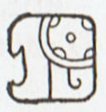 |
 |
 |
|
16 Pax (320) |
17
Kayab |
18 Cumhu |
19
Vayeb (365) |
|
... The [tun]
glyph is nearly the
same as that for the
month Pax ...
except that the top
part of the latter
is split or divided
by two curving
lines. Brinton,
without referring to
the Pax
glyph, identified
the tun glyph
as the drum called
in Yucatec pax
che (pax
'musical
instrument'; che
< *te
'wooden). Yucatec
pax means
'broken,
disappeared', and
Quiche paxih
means, among other
things, 'split,
divide, break,
separate'. It would
seem that the
dividing lines on
the Pax glyph
may have been used
as a semantic/
phonetic
determinative
indicating that the
drum should be read
pax, not
tun ... Thus,
one may expect that
this glyph was used
elsewhere meaning
'to break' and
possibly for
'medicine' (Yuc.
pax, Tzel., Tzo.
pox) ... It
should be added that
tun was also
the period of 18
months, or 360 days
... |
|
... The ground, the
food-giving earth,
was Pachamama;
the moon,
Paximama
...
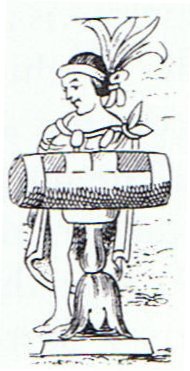
... The tun
glyph was identified
as a wooden drum by
Brinton ... and
Marshal H. Saville
immediately accepted
it ... [the figure
above] shows the
Aztec drum
representation
relied on by Brinton
to demonstrate his
point. It was not
then known that an
ancestral Mayan word
for drum was *tun:
Yucatec tunkul
'divine drum' (?);
Quiche tun
'hollow log drum';
Chorti tun
'hollow log drum'
...
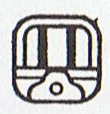 |

The synodic cycle
of the thunder god (Jupiter,
etc) - who was also the god of
lightning who brought fire - was
a fraction more than 398 days:
|
Synodic
cycles |
|
Mercury |
115.88 |
|
Venus |
583.92 |
|
|
|
Mars |
779.96 |
|
Jupiter |
398.88 |
|
Saturn |
378.09 |
|
Uranus |
369.66 |
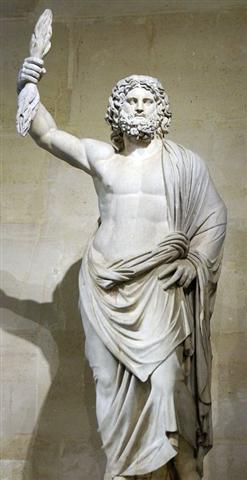
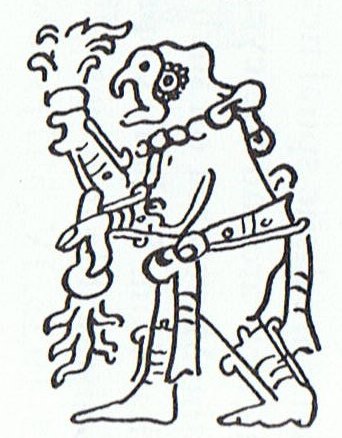
398 - 6 = 392 = 56 weeks = 14 * 28
days.
In the G text we have read:
|
FEBRUARY 17 (413 = 14 * 29½) |
18 (49) |
 |
 |
|
Gb7-30 |
Gb7-31 |
|
April 22 (477) |
23 (113) |
|
°April 18 (473) |
19 (*29) |
|
'March 26 (450) |
27 (*371) |
|
FEBRUARY 19 |
20 (*336) |
21 |
22 (53) |
TERMINALIA |
 |
 |
 |
 |
 |
|
Gb8-1 |
Gb8-2 |
Gb8-3 (444) |
Gb8-4 |
Gb8-5 |
|
April 24 (*399) |
25 |
6 (*36) |
27 |
28 (118 =
54 + 64) |
|
°April 20 |
21 (111) |
22 (*32) |
23 |
24 (*399
= *339 + 60) |
|
'March 28 (*372) |
29 |
30 |
31 |
'April 1
(91) |
At Gb7-30 Arcturus was close to the
Full Moon, and 7 * 30 = 210 = 398 - 188 (= 183 + 5).
The silent bird in Cb1-11 could have corresponded to the
last day of Moan, the Mayan 20-day month
before the first day of Pax:
|
FEBRUARY 17 (413 = 14 * 29½) |
182 |
AUGUST 19 (*151) |
 |
 |
|
Gb7-30 |
Cb1-6 (398) |
|
*32 + 366 = *398
April 22 (477 = 112 + 365) |
ARCTURUS (*215)
October 22 (295) |
|
ARCTURUS (295)
October 22 (*215 = *32 + 183) |
*32
April 22 (112 = 295 - 183) |
|
AUGUST 19 (231 = 48 + 183) |
FEBRUARY 17 (48 = 413 - 365) |
 |
 |
 |
 |
 |
 |
|
Cb1-7 |
Cb1-8 |
Cb1-9 |
Cb1-10 |
Cb1-11 (398 + 5) |
Cb1-12 |
|
rutua te maeva - atua
rerorero - atua hiko ura - hiko o tea - ka
higa te ao ko te henua ra ma te hoi atua |
manu rere - kua rere ga
manu - ki te ragi |
|
CLOSE TO THE SUN: |
|
(*95 +
121)
October 23 |
*217
24 |
*218
25 |
*219
26 |
*220
(300 = 295 + 5) |
*221
28 |
|
CLOSE TO THE FULL MOON: |
|
MIRA (*216 - 183)
April 23 |
*34
24 |
*35
25 (115) |
*36
26 |
*37
27 |
*38
28 (118 = 4 * 29½) |
|
FEBR 18 (414) |
19 |
20 |
21 |
22 |
TERMINALIA |
A pair of figures with mata
heads were here (in Gb7-30) depicted as separated by 3 kinds of limbs. In front
there is a special kind of leg, in the center there is a
human arm,
and at left there seems to be a less substantial
such arm.
At far right a
little offspring appears, perhaps broken off from
the previous leg, or perhaps where earlier there had
been a 4th severed and now absent (sacrificed)
member.
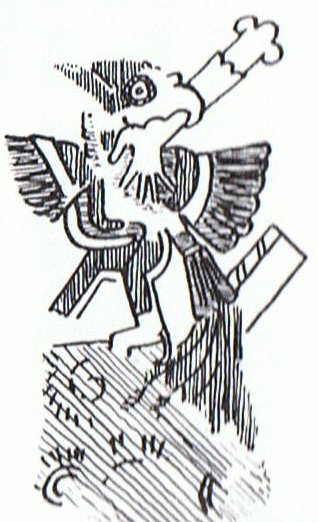
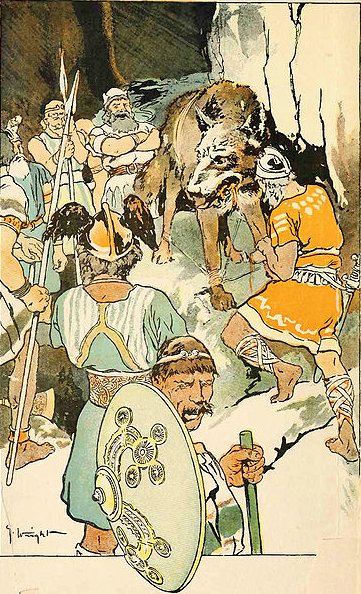
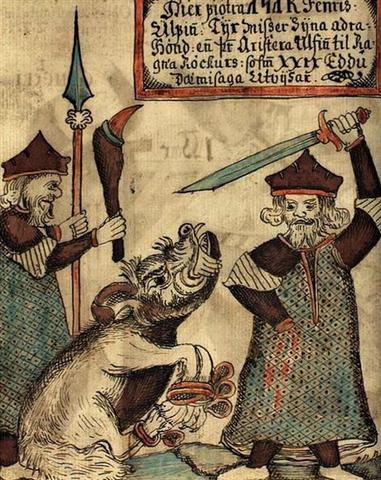
...
After
they had departed from Pu Pakakina they
reached Vai Marama and met a man. Ira
asked, 'How many are you?' He answered, 'There were
two of us'.
Ira
continued asking, 'Where is he (the other)?' To that
he answered, 'The one died'.
Again
Ira asked, 'Who has died?' He replied, 'That
was Te Ohiro A Te Runu'.
Ira asked anew, 'And who are you?' He answered, 'Nga
Tavake A Te Rona'
...

The name of this survivor seems to allude
to Hua Tava, to the father of Kuukuu.
| Ga
Preposed plural marker of rare usage. 1. Sometimes used with a few nouns denoting human beings, more often omitted. Te ga vî'e, te ga poki, the women and the children. Ga rauhiva twins. 2. Used with some proper names. Ga Vaka, Alpha and Beta Centauri (lit. Canoes). Vanaga. |
| Tava
Tavatava, pale. Tavake, sea bird, white, with rosy tail; its feathers were used to decorate hats and belts. Vanaga. Mgv.: A shellfish. To.: tava-amanu, id. Tavake, a seabird with a long red tail. Mq.: toavake, toae, the tropic bird. Sa.: tava'e, id. Ta.: Tavare, to trick, to dupe. Mq.: tavae, to cajole, to flatter. Ma.: taware, to dupe, to fool.. Mq.: Tavatava, a fish. Sa.: tavatava, id. Ha.: kawakawa, id. Churchill.
Tavari, the plant Polygonum acuminatum grows on the crater lakes in close association with rushes and seems to have been used for medicinal purposes. Barthel 2. |
| Rona
Figure made of wood, or stone, or painted, representing a bird, a birdman, a lizard, etc. Vanaga. Drawing, traction. Pau.: ronarona, to pull one another about. Churchill. While the rongorongo signs (rona) are generally 'carved out, incised' (motu), ta implies an incision ('cutting, beating') as well as the process of applying signs to the surface with the aid of a dye ... RAP. rona means primarily 'sign' (an individual sign in the Rongorongo script or a painted or carved sign made on a firm background, such as a petroglyph), but also 'sculpture' (made from wood or stone, representing animals of hybrid creatures) ... rona (lona) implies the idea of 'maintaining a straight line' with ropes and nets and also the maintaining of a steady course (in MAO. and TUA.).
Te Rona is the name of a star in TUA., which Makemson (1941:251) derives from the mythical figure of 'Rona', who is connected with the moon and is considered to be the father of (the moon goddess) Hina (for this role in MAO., see Tregear 1891:423). From west Polynesia come totally different meanings. Interesting perhaps is FIJ. lona, 'to wonder what one is to eat, fasting for the dead.' ... Barthel 2 |
| Sons of Hau Maka |
Sons of Hua Tava |
| Ira |
Sun |
Kuukuu |
Mars |
Nga Tavake A Te Rona |
| Raparenga |
Moon |
Ringiringi |
Mercury |
Te Ohiro A Te Runu |
| |
Nonoma |
Jupiter |
| Uure |
Venus |
| Makoi |
Saturn |
| Runu
To take, to grab with the hand; to receive, to welcome someone in one's home. Ko Timoteo Pakarati ku-runu-rivariva-á ki a au i toona hare, Timoteo Pakarati received me well in his house. Runurunu, iterative of runu: to take continuously, to collect. Vanaga. 1. To pluck, to pick, a burden. 2. A substitute; runurunu, a representative. Churchill. |
|
































